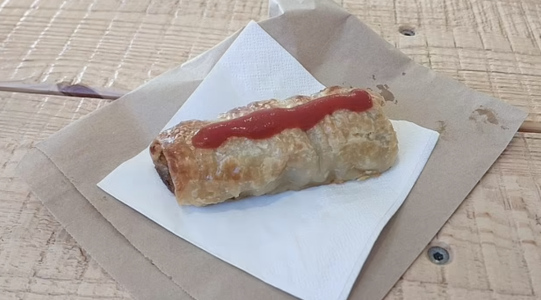Why is this mini sausage roll outrageously overpriced?
- Replies 25
This week, a photo of a tiny sausage roll costing $9 at a cafe set off a fierce debate about 'shrinkflation'—where customers pay more for less—all across Australia.
The photo of the bite-sized package, barely bigger than a serviette, quickly drew the attention of many Aussies, all asking the same question: Aren't prices already expensive enough?
'$8+$1 for sauce. As un-Australian as it gets,' declared one person on Facebook.
'Seriously, nine bucks is ridiculous!' commented another.
On the other hand, some people weren't satisfied with such outrage and argued that the Cairns-based cafe was only charging high prices due to the increased costs it had to bear.
'Well, don't buy it next time,' said one person.
'Small businesses have bills to pay, too, you know. With everything going up in price, to make any money out of the day, these businesses have to put up their prices too.'
Others echoed this sentiment and accused customers of being too willing to pay inflated costs.
'Every day, it's a similar post. They charge it because i****s pay for it,' one commenter argued.
For those who may not be familiar with the term, 'shrinkflation' occurs when brands reduce the size of their products while keeping the same (or even higher) prices. This practice has been happening in Australia and worldwide for years and seems to be on the rise.
We're all aware that food prices are rising, making many wonder if we're getting less value for our money. However, this question is not easy to answer due to the frequent changes in prices and sizes, which are often hard to spot.
In a previous article, we reported that brands like Nescafé, Coke, Snickers, Oreos, Glad Wrap, and Smith's chips, among others, have allegedly reduced the quantity of their products in Australian supermarkets without giving customers prior notice.
Read more about it here.
What causes shrinkflation?
Rising production costs primarily drive shrinkflation. When the prices of ingredients, raw materials, energy, and labour increase, it puts pressure on producers' profit margins.
To combat this, producers sometimes reduce their products' weight, volume, or quantity while maintaining the same price on the label. This helps them protect their profit margins without consumers immediately noticing the change. In this way, they can sustain their sales volume.
Intense competition in the marketplace, especially in industries like food and beverages, also significantly contributes to shrinkflation. With numerous options available, producers strive to keep their customers loyal and their profits intact. This often leads them to resort to tactics like shrinkflation to stay competitive.

So, members, we'd like to hear your thoughts. Have you also noticed more and more items on supermarket shelves undergoing 'shrinkflation'? Please share your observations with us in the comments below.
The photo of the bite-sized package, barely bigger than a serviette, quickly drew the attention of many Aussies, all asking the same question: Aren't prices already expensive enough?
'$8+$1 for sauce. As un-Australian as it gets,' declared one person on Facebook.
'Seriously, nine bucks is ridiculous!' commented another.
On the other hand, some people weren't satisfied with such outrage and argued that the Cairns-based cafe was only charging high prices due to the increased costs it had to bear.
'Well, don't buy it next time,' said one person.
'Small businesses have bills to pay, too, you know. With everything going up in price, to make any money out of the day, these businesses have to put up their prices too.'
Others echoed this sentiment and accused customers of being too willing to pay inflated costs.
'Every day, it's a similar post. They charge it because i****s pay for it,' one commenter argued.
For those who may not be familiar with the term, 'shrinkflation' occurs when brands reduce the size of their products while keeping the same (or even higher) prices. This practice has been happening in Australia and worldwide for years and seems to be on the rise.
We're all aware that food prices are rising, making many wonder if we're getting less value for our money. However, this question is not easy to answer due to the frequent changes in prices and sizes, which are often hard to spot.
In a previous article, we reported that brands like Nescafé, Coke, Snickers, Oreos, Glad Wrap, and Smith's chips, among others, have allegedly reduced the quantity of their products in Australian supermarkets without giving customers prior notice.
Read more about it here.
What causes shrinkflation?
Rising production costs primarily drive shrinkflation. When the prices of ingredients, raw materials, energy, and labour increase, it puts pressure on producers' profit margins.
To combat this, producers sometimes reduce their products' weight, volume, or quantity while maintaining the same price on the label. This helps them protect their profit margins without consumers immediately noticing the change. In this way, they can sustain their sales volume.
Intense competition in the marketplace, especially in industries like food and beverages, also significantly contributes to shrinkflation. With numerous options available, producers strive to keep their customers loyal and their profits intact. This often leads them to resort to tactics like shrinkflation to stay competitive.
Key Takeaways
- A photo of a small sausage roll sold for $9 has caused 'shrinkflation' outrage among Australians.
- The customer bought the sausage roll from a cafe in Cairns, Queensland and was disappointed by its size.
- Some social media users related the price to increased operating costs for small businesses and accused others of being willing to pay inflated prices.
So, members, we'd like to hear your thoughts. Have you also noticed more and more items on supermarket shelves undergoing 'shrinkflation'? Please share your observations with us in the comments below.








